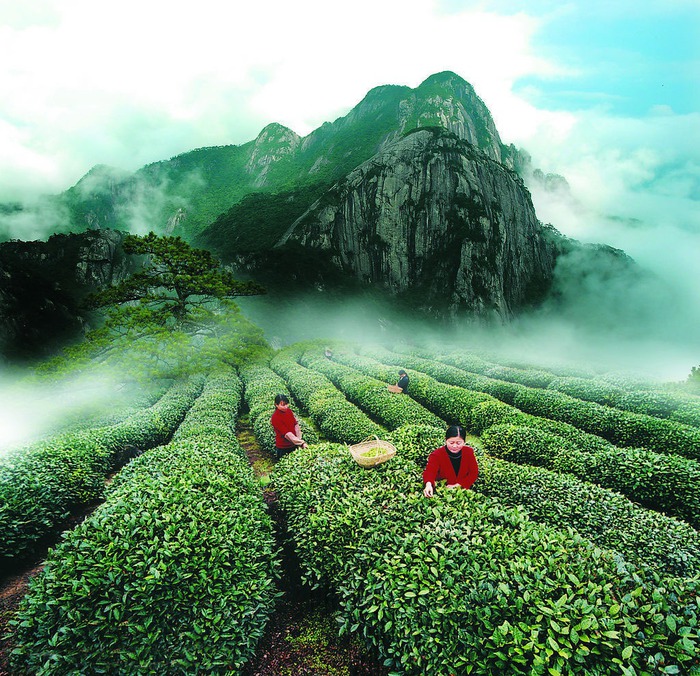
Indian varieties are complete and rich, full flavor infusion. But in India, also produce a lot more sophisticated varieties of tea that is comparable in quality with the Chinese elite varieties.
The largest center of tea production in India is a district of Assam, which covers both sides of the valley of the Brahmaputra River and is bordered along with China, Bhutan, Burma and Bangladesh. Unlike other black teas of India, Assam teas are grown not in the mountains and on the plains. Tea plantations, shaded openwork shade of silver oak, acacia and other trees, are concentrated in the upper part of the valley of the Brahmaputra, which receives abundant rainfall and soil which are particularly favorable for the cultivation of tea. Assam green bushes grow in the richest hunting reserve of India. Tea grown annually, from which we obtain a strong spicy drink, making Assam so famous in the world.

Assam - the birthplace of Indian tea. Over 165 years ago, in 1823, Robert the Bruce found a wild plant in the area, and in 1839 the first 8 boxes of Indian tea from Assam were taken at a London auction. The leaves of this tea are covered with lots of silver hair, and they give the tea its distinctive properties. Assam both the first and second collection give his characteristic taste, in addition to the integral of the fortress. In general, Assam teas are considered classic Indian. They mainly morning, maroon, with a tart, astringent, malty-spicy taste, rich, splendid infusion. They are one of the most saturated black teas and can be used for beverage preparation even with hard water. Remember, if the fortress - Your weakness, then, Assam - this is your tea.
Darjeeling, located to the west of Assam and also bordering with China and Bhutan, is a unique mountain area at the edge of the snowy peaks of the Himalayas with views on a clear day on the individual contours of the Everest ... Here at an altitude of 2000 m above sea level and is located above the tea plantations .
All natural conditions: a cool climate, rainfall, altitude, location, soil, air itself created to leaf tea bush could give rare species especially fragrant tea with intoxicating taste, called champagne.
Almost the entire collection of Darjeeling tea leaves is the production of black tea, harvested and processed in the traditional way. It is a large leaf tea with dark maroon and green tea leaves shimmer, well twisted and covered with lots of silvery hairs, especially in the first two charges. Darjeeling tea is close to the northern Chinese teas and, in the language of experts, characterized in that it gives an intense, bright, velvety infusion and memorable honey rozanisty shade of taste and aroma. On the first, April, assembly deserves mention. Tea made from it goes to the auctions unthinkable a high price, and fight for it as foreign buyers, and very wealthy residents of India. Tea collection is delivered to the first customers aircraft in a matter of weeks after manufacture.
unique climatic conditions of high mountains, slow vegetation leaf tea contribute to the fact that tea Darjeeling becomes quite unusual and rare taste aromatic qualities: sweet muscat flavor, exquisite bouquet, unique thin and rich in nuances flavor.
Title Nilgiri means Blue Mountains. Stretching across the land overflowing with wild life and lush vegetation - they are sources for thousands of streams and rivers. One of the most impressive mountains of South India Nilgiri are very close to the harsh and majestic Western Gatash. Amid all this idyll and Nilgiri tea grows. Tea plantations are located in the eucalyptus trees, blue kamednyh trees and cypresses, curving rivers and waterfalls breaking away, at altitudes ranging from 30 to 2000 m above sea level. Nature in the Blue Mountains is marked generosity. Tea fields stretched all the slopes, valleys and plateaus, in every nook and cranny, which can give the harvest.

Nilgiri tea is relatively soft, growing throughout the year, in contrast to the seasonal Assam and Darjeeling. He is known for his vivid and bright infusion, pleasant, light taste. Across the globe, tea connoisseurs love it real, refined taste. Hence come teas are known for their high quality and flavor characteristics. Achieving this superiority is ensured by combining soil, climate and water. Refined taste comes from the processing of Nilgiri. This amazing sheet gives a very high quality brew with a strong and distinct taste: drinking features - the main advantage of these teas.Nilgiri drink gives great strength and density.
No comments:
Post a Comment